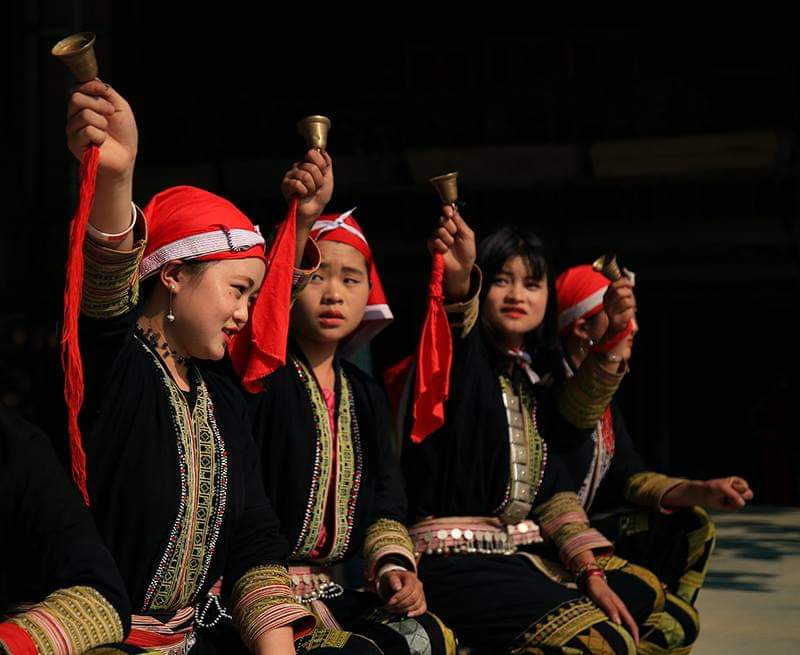Green Mong people keep weaving
In the middle of August, the autumn sky was clear and blue, along a long slope, after two hours of walking, we went up the mountain to visit the green Mong village - a very few people, only less than 1,000 people. This is the only ethnic group found only in Tu Thuong village, Nam Xe commune (Van Ban district, Lao Cai province). Looking down from above the mountain, the terraced fields have begun to turn green to yellow. An entire valley, with an upturned bowl-shaped hill, a rotating terraced field, looked like a giant rice tray, round and round, signaling a prosperous season. Next to the rock at the beginning of the village, the women sit in the sun, peacefully in the middle of the sky to collect the light breeze, peacefully spinning and splicing to weave fabrics ...Artist Ly Thi Sai grinned warmly to welcome us in the green traditional wooden house. She is one of the few remaining old people in this high mountain village who is fluent in singing green Mong folk songs, good at weaving, sewing, and embroidery. Knowing we learned about the process of weaving, Mrs. Ly Thi Sai took her grandson and granddaughter in 10th grade with us to go to the garden to grow flax (also called jute) near her home. Just introduced us to flax cultivation, it was also an opportunity to teach her how to collect flax, dry flax, and strip jute to make fibers. Normally, every 3-4 months, it starts to have early summer rains. Green Mong people sow flax seeds. After 2-3 months of planting, they can collect flax stalks to make fibers. Mrs. Ly Thi Sai can no longer remember when she knew how to weave. Only knowing that, from a young age, she was also taken up by her mother to grow flax, stripped the fibers and grew up, she was also taught how to weave and sew clothes by her grandmother. In the opinion of the Mong, jute or flax for weaving is considered as a cultural symbol, helping the Mong to have a unique craft ...

Mrs. Ly Thi Sai taught her grandson to collect jute trees and weave fabrics
According to her story, she was about the same age as her niece now, green Mong girl Ly Thi Sai is at the age of a full moon, she is about to get married, so her mother has taught how to weave and dye. indigo, sewing clothes so that in the future, my husband will still know work. Ms. Ly Thi Sai confided: Back then, when I got married, I also knew how to weave, sew, and embroider. On the wedding day, the biological parents gave a new dress. According to the traditional custom of the Green Mong people, when women go to their husbands' house, they make their own dresses and dresses for their children and their parents-in-law. So, from that time until now, in addition to the shifting time, I spun, weave, sew clothes, and dress for the whole family. Weaving is a measure of virtue, ingenuity and hard work of a green Mong woman. Therefore, as a woman, everyone has to know how to weave fabrics, make their own dresses ...

Hang out the flax plant
Also because of the tradition of wearing the own clothes of the Green Mong people, most of the Green Mong people in Tu Thuong village do each family, the women in the family know and have to weave their own clothes and clothes. relatives in the family. Vang Thi Nam, grandson of Mrs. Ly Thi Sai, is 15 years old, but she is also taught how to spin and weave by her grandmother. Nam's mother and her uncle-in-law were also given the job by her grandmother, so everyone knew how to do it. Vang Thi Nam shared: I love to be taught and taught how to make clothes by my grandmother. Since I was young, I watched her stripping linen, spinning, weaving and embroidering brocade patterns to make dresses. But the hardest and longest time is to connect the thread into jute thread to weave the fabric. If you don't know how to do it, your hand will be cut and your hands hurt. As a girl, I also like to learn the traditional trades of my people in order to preserve the traditions from being lost in the future. Already a green Mong, a son must be able to play the flute, khèn, play spinning, and girls like me must know how to sing folk songs, weave fabrics, make dresses ...

The most difficult is the stripping and splicing of the yarn.
Sitting next to the traditional weaving frame, Mrs. Ly Thi Sai steadily carried the bobbins back and forth, just once, finished singing the Mong folk song about weaving, also when Mrs. Sai was able to weave a rather long stretch of fabric. into the spool. Just like that, she said, when it is free time, especially in the evening after the rice is finished, she has time to sit on the loom. Mrs. Ly Thi Sai pondered: Nowadays, many families no longer wear traditional clothes, go to the fields every day, they also wear the same as the Kinh people, only during Tet holidays do the green Mong people bring them to wear. Because to make a traditional dress like this, it takes a year, through many elaborate steps, from planting flax, harvesting, drying, crushing flax shell, boiling flax, stripping yarn and connecting yarn, then weaving, dyeing indigo, sewing into shirts, many women are no longer interested in weaving fabrics.

Weaving is an expression of the skill and hard work of a green Mong woman.
The concern of Mrs. Ly Thi Sai is also that of the Nam Xe commune authority, so recently, the commune has propagated and mobilized people to preserve culture and preserve traditional professions. Mobilizing the elderly and artisans like Mrs. Ly Thi Sai to actively keep the profession and pass it on to her children and grandchildren so that they will not be lost in the future. Mr. Vang A To, Chairman of the People's Committee of Nam Xe commune, also a child of the Green Mong ethnic group shared: In addition to preserving the cultural beauty for the community and the village, it also has cultural identity, because the Green Mong people are a very few people, only in Lao Cai. Traditional fabric weaving as well as other cultural identities in beliefs, rituals and daily life must be preserved to create a unique identity of the Green Mong ethnic group./.















